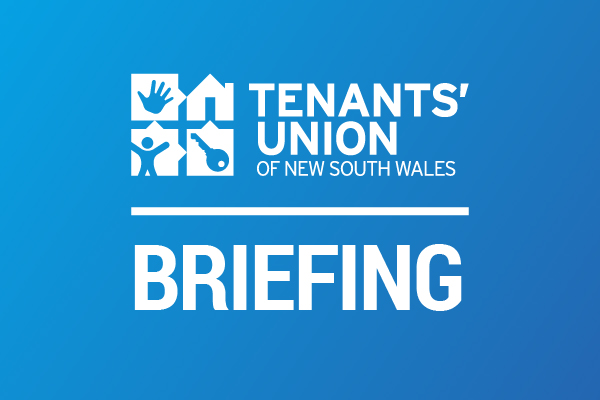Briefing: Occupancy Agreements
01/07/2011
Most NSW renters are covered by the Residential Tenancies Act 2010 (NSW), which sets out important legal rights and obligations and provides effective dispute resolution through the Consumer, Trader and Tenancy Tribunal.
Some renters, however, are not covered by the Residential Tenancies Act 2010 or any similar legislation. These marginal renters – including boarders, lodgers and many share house occupants – have no legislated rights in relation to their housing and no means of dispute resolution through the Tribunal. Instead, marginal renters must rely on the common law of contract for the terms of their rental agreements, and the Supreme Court for dispute resolution.
In practice, the law of New South Wales is of no use to marginal renters, who are some of the most vulnerable people in our community.
The TU proposes that New South Wales should implement new legislation for marginal renters. This model is based on legislation in the Australian Capital Territory for ‘occupancy agreements’ (Residential Tenancies Amendment Act 2004 (ACT), Part 5A).
The elements of this new model of law reform are:
- broad application
- some basic, non-prescriptive legislated rights
- provision for the creation of standard terms by Regulation
- dispute resolution by the Tribunal.
The occupancy agreements model of law reform
This model of law reform creates a scheme of enforceable agreements for all renters not covered by current residential tenancies legislation, and a process for the creation of specific standard terms, each made according to the different conditions of the class of accommodation to which it applies.
Following the ACT legislation, we refer to this as the occupancy agreements model. Its elements are:
Broad application
In New South Wales, occupancy legislation would apply generally where a person contracts, for value, for a right to occupy premises as a residence and where the Residential Tenancies Act 2010 or similar legislation (such as theResidential Parks Act 1998, the Retirement Villages Act 1999 and the Landlord and Tenant Amendment Act 1948) does not apply.
This avoids the inequity of some classes of persons being covered while other similar persons are not, and discourages landlords from manipulating definitional loopholes to escape coverage.
Some basic, non-prescriptive, legislated rights
Referred to as ‘occupancy principles’ in the ACT legislation, these basic provisions are deemed to be part of all occupancy agreements.
In contrast to the prescriptive approach taken in other residential tenancies legislation, by which specific notice periods and other details are fixed for all parties, these principles are less prescriptive.
Some of these occupancy principles are:
- the premises should be reasonably clean and in a reasonable state of repair;
- the landlord is entitled to enter the premises at a reasonable time and on reasonable grounds;
- an occupant is entitled to know the rules of the premises before moving in;
- the occupant is entitled to know how an agreement may be terminated, and to ‘reasonable notice’ of the termination.
In each case, what is ‘reasonable’ may depend on the circumstances of the agreement and the type of accommodation provided.
Provision for standard terms by Regulation
These standard terms would provide the detailed contents of agreements between parties, such as notice periods, grounds for termination and other matters not specified in the occupancy principles. This aspect of the model balances its broad application by allowing for different standard terms to apply to different sorts of accommodation. For example, one set of standard terms might be created for licensed residential centres, another for unlicensed lodging houses, and yet another set for student accommodation.
Dispute resolution by the Tribunal
This provision would afford both parties to an agreement the relatively cheap, quick and accessible dispute resolution processes of the Consumer, Trader and Tenancy Tribunal.
The ACT legislation – positive signs
A positive sign of the benefits of the occupancy agreements model is the development of standard occupancy agreements for accommodation provided by Supported Accommodation Assistance Program (SAAP) services in the ACT.
Two sets of standard terms have been developed – one for overnight accommodation, the other for longer-term accommodation – by the SAAP sector in consultation with representatives of SAAP clients.
These two sets of standards terms are being ‘road-tested’ through use by SAAP services and their clients, before possible adoption as Regulations under the ACT legislation.
See also:


